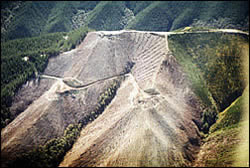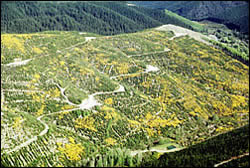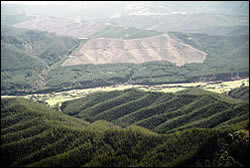Forest harvesting effects
Research Status: Ongoing |
Steepland forest harvesting Richmond Range |
Introduction
The potential for erosion and sediment generation within forests is one of the major environmental effects facing the forest industry in New Zealand. In particular, the harvesting phase has the potential to cause a range of environmental impacts many of which are manifested off-site in streams and estuaries.
One of the most significant potential effects arises from operations associated with either construction of roads or infrastructure related to harvesting. These effects are usually related to erosion or the products of erosion, i.e. sediment.
Erosion has the potential to reduce on-site productivity and cause loss or damage to the forest infrastructure. Sediment has two main impacts. Firstly, it can increase the turbidity of stream water (= decrease clarity), and secondly, it can clog stream beds and downstream receiving environments such as estuaries and lakes. Both of these impacts affect the biological community and health of an ecosystem.
The measurement of sediment production is both costly and difficult. Sediment generation is often random in both a spatial and a temporal sense. Erosion is generally caused by a climatic event exceeding some threshold for an erosion process. While the prediction of such an event is often possible and is of a stochastic nature, the prediction of the exact location at which a particular erosion process occurs (e.g. a landslide) is extremely difficult.
Research Approach
While not an explicit part of the ICM programme, Chris Phillips & Michael Marden are determining how forestry operations, particularly those associated with harvesting, affect sediment generation and delivery to streams. They have been measuring sediment generation at a number of localities in North Island plantation forests using a variety of runoff plots and collectors. Their current efforts are focused at Whangapoua Forest in the Coromandel where they are looking at sediment generation and delivery to sterams at a range of scales.
They have also been investigating the rate at which vegetation recovers on harvested cutover in these forests, because there is a strong relationship between sediment generation or surface erosion and the amount of ground-cover vegetation. Conversely, there is a strong relationship between the degree of soil disturbance and vegetation recovery, with the sites of deepest disturbance taking the longest time to recover. Overall, however, ground-cover vegetation recovery is rapid in most environments.
Elements of current and future work will focus on the granite and Moutere gravels in the Nelson-Motueka region as part of the sediment generation and delivery research project and the sediment learning group.
Research Results
Some relevant publications from this work:
Phillips CJ, Weir P, Quinn J, Marden M, Nelson C 2007. Riparian buffers in the New Zealand Forestry context: are they effective? (Abstract) Conference: Riparian Management in Headwater Catchments: Translating Science into Management Vancouver, Canada, 19-21 Feb 2007.
Phillips CJ, Marden M 2006. Sediment generation and sediment yield following harvesting on the Coromandel: implications for management. (Abstract) p 91 in Proceedings of ôResource management under stormy skies: water allocation @ the crossroads? Conference programme and abstracts. November 20-23, 2006, Christchurch.
Marden M, Rowan D, Phillips C 2006. Sediment sources and delivery following plantation harvesting in a weathered volcanic terrain, Coromandel Peninsula, North Island, New Zealand. Australian Journal of Soil Research 44: 219-232.
Phillips CJ, Marden M 2005. Reforestation schemes to manage regional landslide risk. Chapter 18 in Landslide Hazard and Risk Edited by Glade T, Anderson M and Crozier MJ p517-547. 2004 John Wiley & Sons Ltd.
Phillips CJ, Marden M, Rowan D 2005. Sediment yield following plantation harvesting, Coromandel Peninsula, North Island, New Zealand. Journal of Hydrology (NZ) 44(1):29-44.
Phillips CJ, Marden M 2003. Erosion and stormwater control in the Forest industry: past, present and future? Paper to be presented at The 3rd South Pacific Conference on Stormwater and Aquatic Resource Protection. 14-16 May 2003, Auckland, New Zealand.
Phillips CJ Marden M, Rowan D, Garrett L 2002. Soil loss, vegetation recovery, and sediment delivery to streams following plantation harvesting, Coromandel. Programme abstracts from "All the easy water has gone". New Zealand Hydrological Society annual conference, Blenheim, December 3-6, 2002.
Fahey BD, Marden M, Phillips CJ 2003. Sediment yield associated with plantation forestry, coastal Hawke's Bay, North Island, New Zealand. Submitted to Journal of Hydrology (NZ).
Marden M, Phillips CJ, Rowan D 2002. "Soil loss, vegetation recovery, and sediment yield following plantation harvesting, Coromandel - interim results" Programme abstracts from the Soil Quality/ NZ Association of Resource Management Conference in Palmerston North, April 2-5, 2002.
Fransen PJB, Phillips CJ, Fahey BD 2001. Forest road erosion in New Zealand: overview. Earth Surface Processes and Landforms 26: 165-174.
Phillips C 2000. [Poster abstract] Sediment generation following harvesting of Pinus radiata in New Zealand : a variable story. In: Jandl, R.; Devall, M.; Khorchidi, M.; Schimpf, E.; Wolfrum, G.; Krishnapillay, B. eds. XXI IUFRO World Congress 2000 7-12 August 2000, Kuala Lumpur : Forests and society : the role of research : poster abstracts Vol.3. Vienna, IUFRO. P. 458.
 |
 |
Weedy regrowth following harvesting |
Plantations on Moutere Gravels |
Recent Publications
BMPs, BEPs and Guidelines
| Title | Description |
| Standards and Guidelines for Sustainable Management of Indigenous Forests |
From guide: MAF Standards and Guidelines for sustainable management of New Zealand indigenous ...More » |
| The National Standard for Environmental Certification of well–managed Plantation Forests in New Zealand | Outlines the National Standard for environmental certification of plantation forests. It provides f...More » |
| New Zealand Environmental Code of Practice for Plantation Forestry | The E CoP is an essential tool for anyone involved in forest management. Developed by the NZFOA, and...More » |
| Managing Your Bush Block:A guide to looking after indigenous forest remnants in the Wellington region | Tips and techniques of managing bush blocks....More » |
Primary Contacts:

|
Michael Marden
Email Phone: 06 8631345 Fax: 06 8631346 More details» |
Institute Landcare Research |
Expertise Geology/Earth Sciences/Geomorphology/Erosion processes |

|
Chris Phillips
Email Phone: +64 3 321 9775 More details» |
Institute Landcare Research |
Expertise Erosion processes, slope stability, effects of forestry, catchment management, knowledge management |